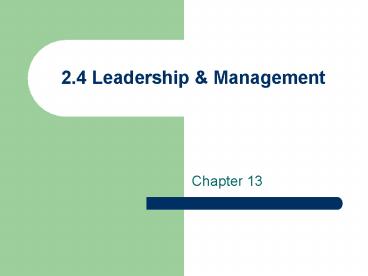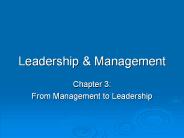2.4 Leadership - PowerPoint PPT Presentation
1 / 14
Title: 2.4 Leadership
1
2.4 Leadership Management
- Chapter 13
2
Leadership Styles
- Autocratic (or Authoritarian)
- Democratic
- Laissez-Faire
- Situational Leadership
3
Autocratic Leadership Style
- A style of leadership that keeps all
decision-making at the center of the
organization. - Features
- Leader makes all decisions
- Supervises workers closely
- Workers have limited information
4
Democratic Leadership Style
- A leadership style that promotes the active
participation of workers in making decisions. - Features
- Participation of workers is encouraged
- Two-way communication with workers
- Workers are given information about the business
to allow full involvement
5
Laissez-Faire Leadership Style
- A leadership style that leaves much of the
business decision-making to the workforce a
Hands On approach. - Features
- Managers delegate virtually all authority to
workers - Employees work within broad limits
6
Situational Leadership Style
- Leadership style varies with the task at hand.
Situational leaders adapt their style to each
situation. - Features
- Style of leadership depends on
- The task
- The groups skill
- The groups willingness to accept responsibility
7
HLWhat Makes a Good Leader?
- Are leaders born?
- OR
- Are leaders made?
- Discuss..
8
HL - Characteristics of Good Leaders
- A desire to succeed and natural self-confidence
- Ability to thing beyond the obvious be creative
and encourage other to do the same - Multi-talented enabling them to understand a wide
range of issues - Able to identify main issues instead of
unnecessary details
9
HL Difference between Leader Manager
Leadership Management
Motivating and inspiring others Directing and monitoring others
Innovators who encourage others to accept change Problem-solvers
Stems from personal qualities or traits Official position of responsibility in the organization
Natural abilities and instincts Skilled and qualified to perform role
Believes in doing the right thing Believes in doing things right
Respected and trusted by followers they want to because of leaders personality Listened to by others because of status not necessarily because of personality
Creates and develops a culture of change Accepts and conforms to the norms of the organization
10
HL - Charles Handy, Henri Fayol, Peter Drucker
noted management authors
- All recognize the following functions of
management - Set objectives and plan
- Organize resources to meet objectives
- Direct and motivate staff
- Coordinate activities
- Control and measure performance against targets
(the set of objectives)
11
HL Henry Mintzbergs Roles of a Manager
- To carry out functions of management, a manager
must undertake different roles. - Interpersonal roles motivating and dealing with
staff - Informational roles acting as a source,
receiver, and transmitter of information - Decisional roles making decisions and
allocating resources to meet objectives
12
HL - Interpersonal Role
Role Description of Activities
Figurehead Symbolic leader of the organization
Leader Motivating subordinates Selecting and training managers/staff
Liaison Linking with managers and leaders of other divisions and organizations
13
HL - Informational Role
Role Description of Activities
Monitor (Receiver) Collecting data relevant to the businesss operations
Disseminator Sending information collected from external and internal sources to the relevant people in the organization
Spokesperson Communicating information about the organization to external groups
14
HL - Decisional Role
Role Description of Activities
Entrepreneur Looking for new opportunities to develop the business
Disturbance Handler Responding to changing situations that may put the business at risk Taking responsibility when threatening factors develop
Resource allocator Deciding on the allocation of the organizations financial, human, and other resources
Negotiator Representing the organization in all important negotiations































